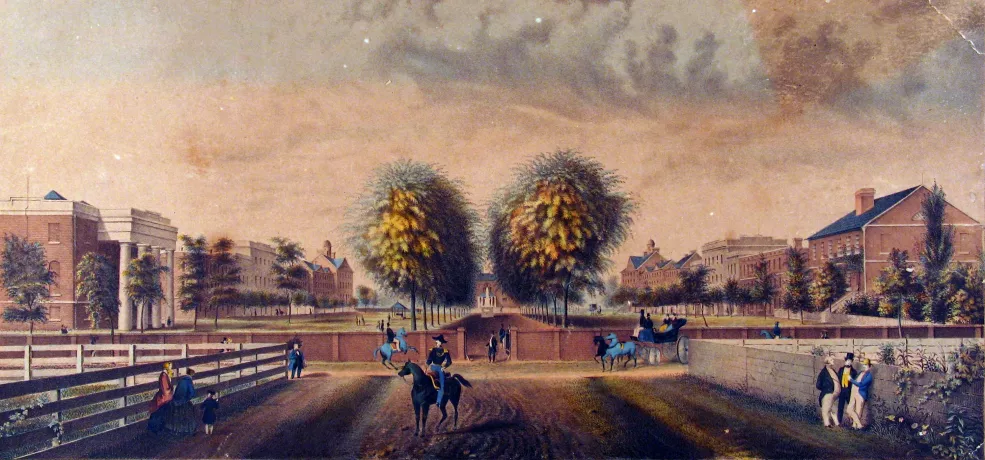Intersection of Sumter and College Streets
South Carolina College
Founded in 1801, South Carolina College (present-day University of South Carolina) officially opened in 1805 with nine students and one faculty member. In the decades leading up to the Civil War, the college became a "finishing school" for sons of the planter class. It also served as a gateway into the political sphere for men from all backgrounds. From its founding, the college relied on enslaved labor. The college owned several enslaved persons, as did faculty members. Although students were not allowed to bring individuals enslaved by their families to campus, they did pay a "servant fee," which supplemented the living expenses of college-owned enslaved persons, as well as those "hired out" to the college by various owners in downtown Columbia. Many alumni would graduate to leadership roles in state and federal government, taking their pro-slavery beliefs with them. Twenty-one South Carolina College graduates signed the Ordinance of Secession in 1860.
On 12 April 1861, the Corps of Cadets (about 106 of the 143 member student body) went to Charleston to fight, effectively closing the college. They pulled guard duty at Sullivans Island, suffered no casualties, and returned home three weeks later to a hero’s welcome by the city.
On 25 June 1862, the Confederacy began using six of the college’s buildings as a hospital (Rutledge, DeSaussure, Harper, Eliott, Legare, and Pinckney). Faculty residences, the library, bursary, and College Hall were not used. Within two years the hospital could accommodate about 500 patients. Nine surgeons and 176 non-medical staff members, of whom about 60% were African American, operated the facility. The college would not officially close until December 2, 1863, although classes had not been held in more than a year.
Most faculty members not directly involved in the war effort remained on campus in their residences. Here, Emma LeConte, daughter of Professor Joseph LeConte, describes the Burning of Columbia on February 17-18, 1865, from her home in present-day Lieber College:
"On every side the crackling and devouring fire, while every instant came the crashing of timbers and the thunder of falling buildings. A quivering molten ocean seemed to fill the air and sky. The Library building opposite us seemed framed by the gushing flames and smoke, while through the windows gleamed the liquid fire. This we thought must be Aunt Josie's house. It was the next one, for although hers caught frequently, it was saved. The College buildings caught all along that dise, and had the incendiary work continued one half hour longer than it did they must have gone. All the physicians and nurses were on the roof trying to save the buildings, and the poor wounded inmates left to themselves, such as could crawled out while those who could not move waited to be burned to death. The Common opposite the gate was crowded with homeless women and children, a few wrapped in blankets and many shivering in the night air."
-(Emma Leconte Diary, 1864-1865. Property of the University of North Carolina, Chapel Hill. Manuscripts Dept., Southern Historical Collection, UNC-CH #420)
Union troops officially took possession of the college on May 25, 1865, and would remain for several years. The college reopened in 1866 as the University of South Carolina, and during the Reconstruction period the university would become the only state-sponsored institution in the south that was integrated.
